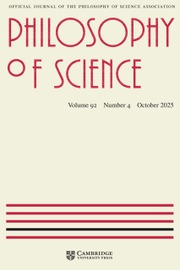No CrossRef data available.
Article contents
The Many Laws of the Periodic Table
Published online by Cambridge University Press: 27 August 2025
Abstract
There are many—not just one—periodic laws in chemistry. These laws correspond to nonaccidental regularity relations about physical and chemical properties of (sets of) chemical elements. I support this by showing how these regularity relations can be understood from the perspective of a philosophical analysis of laws. Specifically, I show that these relations instantiate standard features associated with laws; they can be spelled out in terms of two standard accounts of laws; and they can coherently figure in debates about the reality of laws as plausible candidates of ceteris paribus laws.
Information
- Type
- Contributed Paper
- Information
- Copyright
- © The Author(s), 2025. Published by Cambridge University Press on behalf of Philosophy of Science Association
References
Armstrong, D. M. 1983. What Is a Law of Nature. Cambridge: Cambridge University Press. https://doi.org/10.1017/CBO9781139171700.Google Scholar
Cartwright, N. 1983.
How the Laws of Physics Lie
. Oxford: Oxford University Press. https://doi.org/10.1093/0198247044.003.0001.Google Scholar
Chisholm, R. M. 1955. “Law Statements and Counterfactual Inference.” Analysis 15 (5):97–105. https://doi.org/10.2307/3326359.Google Scholar
Despotopulos, J. D., Kmak, K. N., Gharibyan, N., Henderson, R. A., Moody, K. J., Shaughnessy, D. A., and Sudowe, R.. 2016. “Characterization of the Homologs of Flerovium with Crown Ether Based Extraction Chromatography Resins: Studies in Hydrochloric Acid.” Journal of Radioanalytical and Nuclear Chemistry 310:1201–7. https://doi.org/10.1007/s10967-016-4917-z.Google Scholar
Dobrijevic, M., Hébrard, E., Plessis, S., Carrasco, N., Pernot, P., and Bruno-Claeys, M.. 2010. “Comparison of Methods for the Determination of Key Reactions in Chemical Systems: Application to Titan’s Atmosphere.” Advances in Space Research 45 (1):77–91. https://doi.org/10.1016/j.asr.2009.06.005.Google Scholar
Dretske, F. 1977a. “Referring to Events.” Midwest Studies in Philosophy 2 (1):90–99. https://doi.org/10.1111/j.1475-4975.1977.tb00030.x.Google Scholar
Dretske, F. 1977b. “What Is a Law of Nature?” Philosophy of Science 44:248–68. https://doi.org/10.1086/288741.Google Scholar
Fodor, J. 1989. “Making Mind Matter More.” Philosophical Topics 17:59–79. https://www.jstor.org/stable/43154039.Google Scholar
Friend, T. 2023. “How to Be Humean about Idealization Laws.” Philosophy of Science 90 (1):150–70. https://doi.org/10.1017/psa.2022.12.Google Scholar
Goodman, N. 1947. “The Problem of Counterfactual Conditionals.” The Journal of Philosophy 44 (5):113–28. https://doi.org/10.2307/2019988.Google Scholar
Harré, R. 2012. “Laws in Chemistry.” In Philosophy of Chemistry: Handbook of the Philosophy of Science. ed. by R. Hendry, P. Needham, and A. Woody, Handbook of the Philosophy of Science, Volume 6: Philosophy of Chemistry. Amsterdam: Elsevier pp. 339–54. https://doi.org/10.1016/B978-0-444-51675-6.50025-6.Google Scholar
Hempel, C. G., and Oppenheim, P.. 1948. “Studies in the Logic of Explanation.” Philosophy of Science 15 (2):135–75. https://doi.org/10.1086/286983.Google Scholar
Hendry, Robin Findlay. 2010. “Emergence vs. Reduction in Chemistry.” In Emergence in Mind, Mind Association Occasional Series, edited by Macdonald, Cynthia and Macdonald, Graham, New York: Oxford University Press, pp. 205–21. https://doi.org/10.1093/acprof:oso/9780199583621.001.0001.Google Scholar
Hicks, M. T. 2018. “Dynamic Humeanism.” The British Journal for the Philosophy of Science 69 (4):983–1007. https://doi.org/10.1093/bjps/axx006.Google Scholar
IUPAC. 2014. “Compendium of Chemical Terminology.” Gold Book. Version 2.3.3, http://goldbook.iupac.org/pdf/goldbook.pd.Google Scholar
Kim, Jaegwon. 2010. “14 Why There Are No Laws in the Special Sciences: Three Arguments.” Essays in the Metaphysics of Mind, pp. 282–310. Oxford: Oxford University Press. https://doi.org/10.1093/acprof:oso/9780199585878.003.0015.Google Scholar
Lange, M. 2009. Laws and Lawmakers: Science, Metaphysics, and the Laws of Nature. Oxford: Oxford University Press. https://doi.org/10.1093/acprof:oso/9780195328134.001.0001.Google Scholar
Loewer, B. 1996. Humean Supervenience. Philosophical Topics 24 (1):101–27. http://www.jstor.org/stable/43154224.Google Scholar
Lombardi, O., and Labarca, M.. 2005. “The Ontological Autonomy of the Chemical World.” Foundations of Chemistry 7 (2):125–48. https://doi.org/10.1007/s10698-004-0980-6.Google Scholar
Mill, J. S., 1843, A System of Logic, Ratiocinative and Inductive: Being a Connected View of the Principles of Evidence, and the Methods of Scientific Investigation, two volumes, London: Parker.Google Scholar
Mumford, S. 2004. Laws in Nature (Vol. 18). New York: Routledge. https://doi.org/10.4324/9780203458426.Google Scholar
Psillos, S. 2014. “Regularities, Natural Patterns and Laws of Nature.” Theoria. Revista de Teoría, Historia y Fundamentos de la Ciencia 29 (1):9–27. https://www.redalyc.org/articulo.oa?id=339732248002.Google Scholar
Pulkkinen, K. 2020. “Values in the Development of Early Periodic Tables.” Ambix 67 (2):174–98. https://doi.org/10.1080/00026980.2020.1747325.Google Scholar
Scerri, E. R. 1997. “Has the Periodic Table Been Successfully Axiomatized?” Erkenntnis 47 (2):229–43. https://doi.org/10.1023/A:1005318720779.Google Scholar
Scerri, E. R. 2007. The Periodic Table: Its Story and Its Significance. Oxford: Oxford University Press.Google Scholar
Scerri, E. R. 2020a. “Recent Attempts to Change the Periodic Table.” Philosophical Transactions of the Royal Society A 378 (2180). https://doi.org/10.1098/rsta.2019.0300.Google Scholar
Scerri, E. R. 2020b. “The Periodic Table and the Turn to Practice.” Studies in History and Philosophy of Science Part A 79:87–93. https://doi.org/10.1016/j.shpsa.2019.06.001.Google Scholar
Tooley, M. 1977. “The Nature of Laws.” Canadian Journal of Philosophy 7 (4):667–98. https://doi.org/10.1080/00455091.1977.10716190.Google Scholar
Van Fraassen, B. C. 1989. Laws and Symmetry. Oxford: Clarendon Press. https://doi.org/10.1093/0198248601.001.0001.Google Scholar
Williams, R. J. 1997. “The Natural Selection of the Chemical Elements.” Cell Mol Life Sci. 53 (10):816–29. https://doi.org/10.1007/s000180050102. PMID: 9432285.Google Scholar
Woody, A. I. 2014. “Chemistry’s Periodic Law: Rethinking Representation and Explanation after the Turn to Practice.” In Science after the Practice Turn in Philosophy, History, and the Social Studies of Science, edited by Soler, L., Zwart, S., Lynch, M., and Israel-Jost, V.. London: Routledge Taylor & Francis Group. pp. 123–150 https://doi.org/10.4324/9781315857985.Google Scholar

